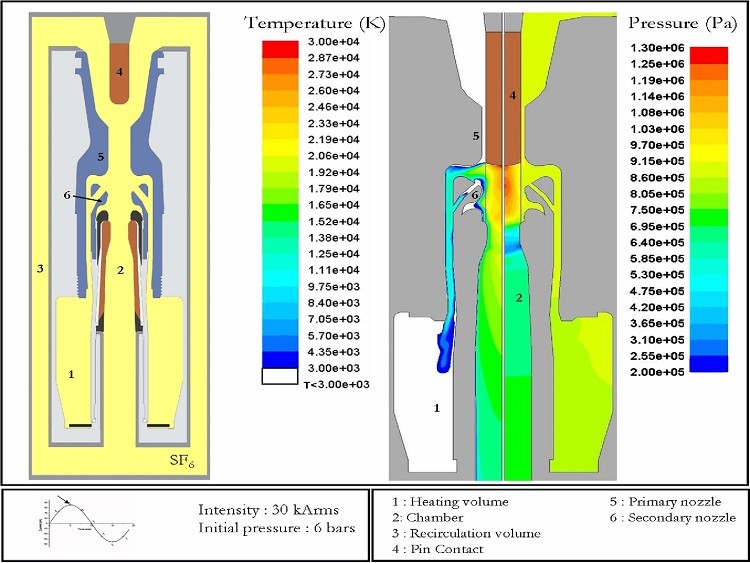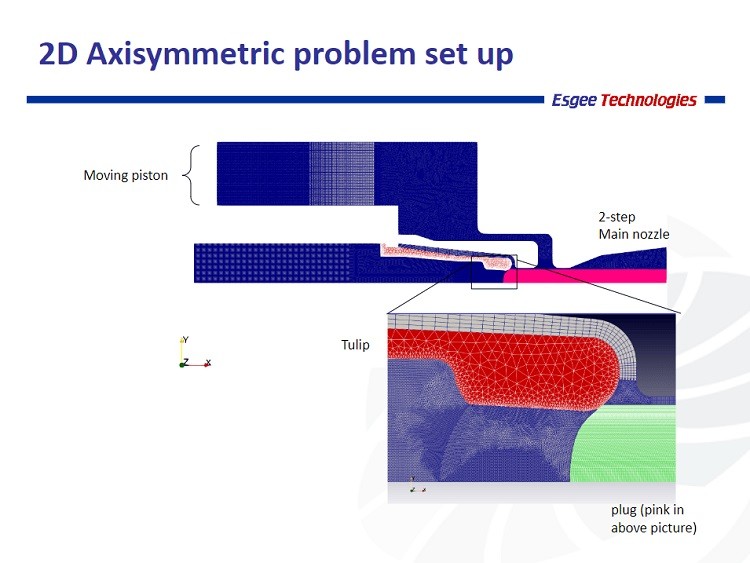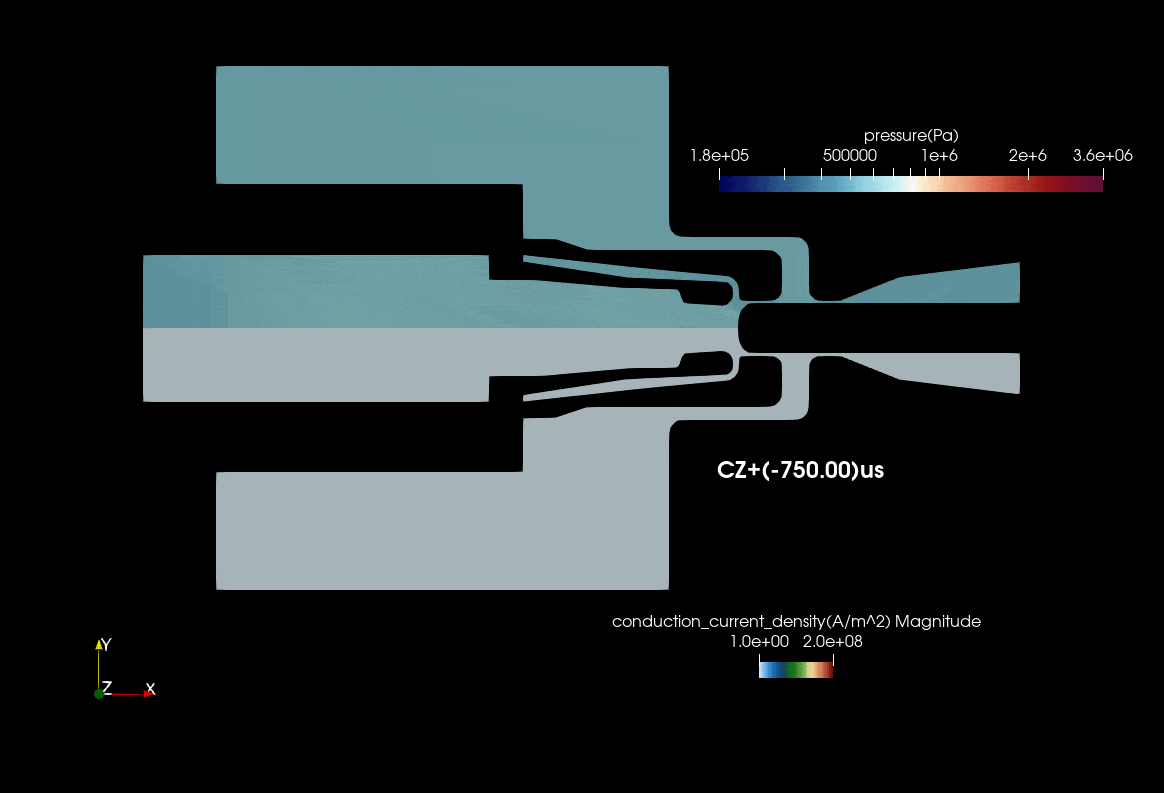
A greater understanding of the arc behavior during a current interruption in the SF6 circuit breaker is an obstacle on the path to a future with efficient, sustainable electric switchgear and interrupters. Dr. Rakesh Ranjan of Esgee Technologies is actively working to realize these goals through the development of high-fidelity plasma simulations for switching arcs. We spoke with Dr. Ranjan to better understand his work:
How do simulations help us understand arcing phenomena in the SF6 circuit breaker?
During any real-world circuit-breaking process, arc behavior is influenced by several factors: circuit specifications (voltage, current), insulation medium (gas pressure, temperature, internal flows, ablation, and subsequent transport in the arcing regions), and actuation system behavior (travel curve of the electrodes during current interruption). Each of these factors has its internal variability and often has nonlinear interdependence. The takeaways from a numerical simulation campaign depend on the end goal (e.g. design process, root cause analysis for a failure). The primary benefits are the deeper insights based on physics and its governing equations. When I post-process and analyze a simulation’s results, I am able to watch physics happen in slow-motion and gain insights in a way unimaginable to physicists before our time.
In highly competitive, industrial domains, such insights are the difference between a good product and a great product.
What makes plasma simulations so challenging and how do you overcome those challenges?
In our typical day-to-day life, we interact with solids, liquids, and gas (unless your day-to-day involves getting electrocuted, you aren’t interacting with plasmas). In these states, the molecules and atoms are neutral. But under extreme conditions (e.g. a strong electric field), electrons and radicals might go rogue and break away. Such a condition creates what is called a “non-equilibrium” plasma, where the kinetics of electrons and atoms have different behavior (and thus, different, non-equilibrated temperatures).
Any arcing – intentional or unintentional – starts with such a process. This presents a major challenge in getting the plasma simulation correct, as it depends on the hundreds of possible chemical reactions that occur during this process.
Another major challenge is getting the high-temperature properties correct. We already know that the arcs are several times hotter than the surface of the sun; in such a hot environment, the gas is a soup of multiple species, and – depending on the species – transport properties of the plasma will change. Getting these properties correct is critical for any valuable simulation tool.
We overcome these challenges by regularly conducting forefront research on different materials, plasma conditions, and subsequent validation against experimental data. To know more, you can Google VizSpark and VizGlow. We have published multiple papers on this subject.
What happens inside a circuit breaker during the current interruption process?
High-voltage circuit breakers are a highly complex system where multiple factors have to be aligned to get the switching arc quench correct. As aforementioned, it is as multiphysics as it gets; inside the circuit breaker, the plug and the tulip are in contact under closed conditions.
a. Contact Separation: During the circuit breaking process, the tulip or plug are moved away from one another (you do this every time you unplug any powered connection).
At the instant of contact separation, the arc channel forms between the plug and the tulip. The arc forms a conductive channel at high temperatures, and electrical conductivity is very high. This means that even though the contacts are not touching each other, the current is flowing through the contacts.
b. Arc Stretching and Quenching: The next step is to quench the arc so that the current is fully interrupted. You can think of this stage as fire-fighting, except that the plasma is much hotter than the fire, and it does not require oxygen to sustain itself. So, in this fire-fighting mode, we employ all the available tools we have. For a gas-based interrupter, this involves cooling and stretching the arc with gas flowing at high speeds toward it. This leads to a decrease in the arc current and ultimately quenches the arc. At this stage, the current would be interrupted as a result.
Additional information about arc behavior during a current interruption in the circuit breaker:
As always, the devil is in the details. During its lifetime, an arc structure is filled with multiple phenomena that directly affect the voltage and current characteristics. The short-circuiting of the plasma channel occurs at the timescale of microseconds and is coupled with an almost instantaneous release of energy in the form of strong pressure waves.
Then, there’s the current zero (CZ). When the current crosses “zero,” the arc cannot sustain itself and momentarily goes weak. At this stage, transient recovery voltage starts to build up on the electrodes within microseconds. If the contacts are not far apart, a strong electric field kicks in and rogue electrons break the gas media into a plasma. So, after the current reaches zero and begins increasing again, the conductive plasma channel provides current conduction.
How do you set up your simulations for arc behavior during a current interruption in the circuit breaker?
Any numerical simulation of a plasma channel would require geometry creation, meshing of the geometry, setting up the boundary conditions, and running the simulation. In VizSpark, governing equations for solids and fluids are fully coupled, so the boundary conditions are provided on the external face of the contact, just like an experimentalist would connect a wire in such a setup. After this, we let the VizSpark solver run for the course of the full simulation.

Fig 1. Sample mesh for numerical simulation
What are the major takeaways from simulations for arc behavior during a current interruption in the circuit breaker?
Depending on the focus of the observer, there could be multiple takeaways from a simulation. The key is the arc behavior – since it is a high-temperature volume – interacting with the flow as well as the solids.
One could design ablative material components based on someone expecting the temperature to be high. Similarly, if someone is carrying out lifetime studies of the circuit breaker, they could change clearances and simulate multiple conditions to see the impact of clearance change on the gas flow pattern. Another use example would be to get insights near current zero conditions. Anyone interested in learning more about post-CZ breakdown will learn a lot from the density maps and electric field information that VizSpark can provide.

Fig 2. Animation showing arc behavior at near-CZ conditions



